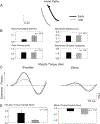Limb position drift: implications for control of posture and movement
- PMID: 14615428
- PMCID: PMC10704426
- DOI: 10.1152/jn.00013.2003
Limb position drift: implications for control of posture and movement
Abstract
In the absence of visual feedback, subject reports of hand location tend to drift over time. Such drift has been attributed to a gradual reduction in the usefulness of proprioception to signal limb position. If this account is correct, drift should degrade the accuracy of movement distance and direction over a series of movements made without visual feedback. To test this hypothesis, we asked participants to perform six series of 75 repetitive movements from a visible start location to a visible target, in time with a regular, audible tone. Fingertip position feedback was given by a cursor during the first five trials in the series. Feedback was then removed, and participants were to continue on pace for the next 70 trials. Movements were made in two directions (30 degrees and 120 degrees ) from each of three start locations (initial shoulder angles of 30 degrees, 40 degrees, 50 degrees, and initial elbow angles of 90 degrees ). Over the 70 trials, the start location of each movement drifted, on average, 8 cm away from the initial start location. This drift varied systematically with movement direction, indicating that drift is related to movement production. However, despite these dramatic changes in hand position and joint configuration, movement distance and direction remained relatively constant. Inverse dynamics analysis revealed that movement preservation was accompanied by substantial modification of joint muscle torque. These results suggest that proprioception continues to be a reliable source of limb position information after prolonged time without vision, but that this information is used differently for maintaining limb position and for specifying movement trajectory.
Figures










References
-
- Adams HF. Autokinetic sensations. Psychol Monogr 14: 1–45, 1912.
-
- Bock O and Arnold K. Error accumulation and error correction in sequential pointing movements. Exp Brain Res 95: 111–117, 1993. - PubMed
-
- Bock O and Eckmiller R. Goal directed arm movements in absence of visual guidance: evidence for amplitude rather than position control. Exp Brain Res 62: 451–458, 1986. - PubMed
Publication types
MeSH terms
Grants and funding
LinkOut - more resources
Full Text Sources
Medical

